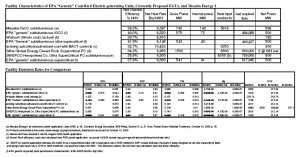What about this EIS???
YEAAAAAAAAAA! RUS EIS is on the way!!!
So what’s the big deal that the Rural Utility Service is doing an EIS on CapX 2020? And just the LaCrosse line part of CapX 2020?
Consider the piss-poor excuse of “environmental review” done in the Certificate of Need proceeding, when what was needed was the level of review in a RUS EIS. Look at the state’s “scope” and look what was EXPRESSLY EXCLUDED:
Then, look at the result:
The state scope is very important because Commerce blew us off, saying that federal review wasn’t going to happen:
And they specifically said an EIS by RUS was not anticipated and blew off so many of us saying that they needed to do a joint EIS:
**************
So now, it appears, there will be an RUS EIS, because of the RUS money going in for Dairyland, and it’s stating what we knew all along. By doing it this way, by doing it at this stage, at this late date, it limits RUS review to just this one part of what we know is one big honkin’ project, not just this Phase I group, but also Phase II and Phase III and who knows what all else. They admit it in their Application, Appendix A-1 where they list the big chart of “common facilities.”
As Carter Bishop always said in Contracts, “Well…. that’s one option.”  Here’s another:
1) The important thing in this RUS EIS is to tie it all together, that this is just one small part of the plan, phased and connected actions, and they must address all:
* Applied for in CoN as ONE PROJECT
* Needs all pieces to work
* Application lists the full spectrum of “common elements” that they want to build (see Application, Appendix A-1)
* The LaX to mid-WI has been announced
* Mississippi River is “only” one crossing and Minnesota River has two, TWICE the impacts, both are designated Scenic Byways, both have Federal Wildlife Management Areas.
2) Systems alternatives must be addressed and the NO BUILD alternative must be addressed – and not “NO BUILD” for just that part, but for ALL OF IT.
3) Another thing to bring in here is impact of this line if it is used for various capacity ranges of coal. The wind lobby talks of getting 700MW of wind, BFD where potential capacity means it’s about 1/6 of capacity… sigh….this was NOT addressed in any way.
* Line has 4,100MVA capacity.
* MISO goal is to displace natural gas with coal
* EIS must address emissions impacts of various scenarios of coal generation on CapX lines (and not just CO2):
o 10% -Â Â Â 410 MW
o 30% – 1,230 MW
o 50% – 2,050 MW
o 75% – 3,033 MW
o 85% – 3,485 MW
Here’s a comparative emissions chart from a recent MPCA analysis, with some ballpark comparative levels for NOx, SO2, PM, Hg, CO2, and you can figure some estimates for 410, 1,230, 2,050, 3,033, 3,485 and 4,100MW of polluting:

In case it’s not legible, here’s the chart in pdf:
MPCA Final – from Mesaba Project
In short, if they put more coal on line, what emissions are enabled? And then, what are impacts, because it would be wafting over Minnesota! Dumping on Minnesota!
That all said, it seems to me that those are the things that need to be addressed in this EIS! Those things that the state wouldn’t touch… wouldn’t touch because they know it poses a problem. Now’s our chance!




Comments
What about this EIS??? — No Comments
HTML tags allowed in your comment: <a href="" title=""> <abbr title=""> <acronym title=""> <b> <blockquote cite=""> <cite> <code> <del datetime=""> <em> <i> <q cite=""> <s> <strike> <strong>